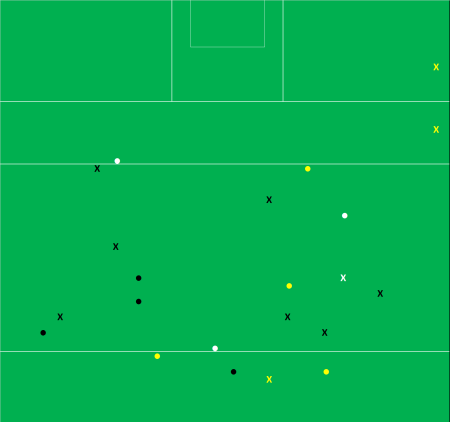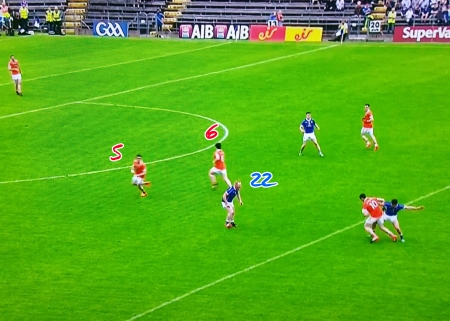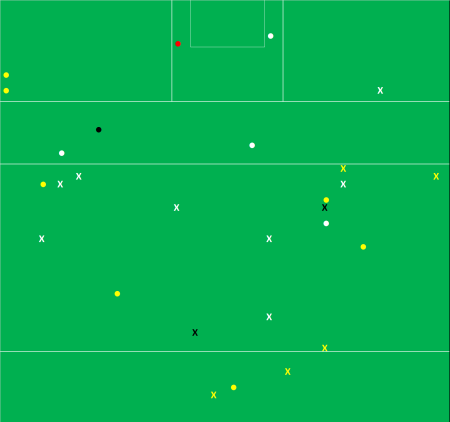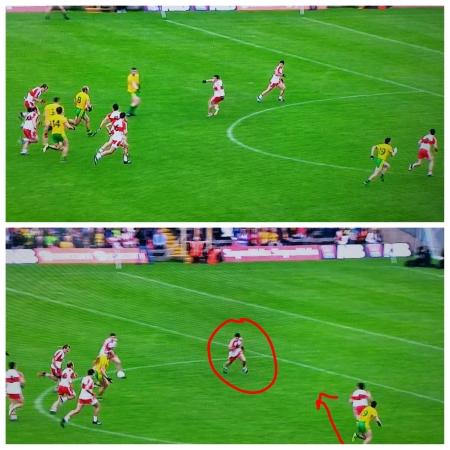For those new to the blog, or who haven’t been here for a while, please find a refresher on the definitions and how the numbers are compiled here
| Team | Possessions | Attacks | Shots | Scores | Exp Pts |
| Derry | 44 | 38 | 26 | 0 – 11 | 13.81 |
| Tyrone | 53 | 49 | 42 | 0 – 22 | 23.59 |
That is as comfortable a game as a team is likely to have. Tyrone had 9 more possessions, 11 more attacks and a whopping 16 more shots than Derry. There are examples of such disparities where teams begin to rack up numbers towards the back end of a game, as the competitive edge has gone out of the encounter, but (sadly) this was not the case here. When the game was – notionally – at its most competitive in the first half Tyrone had six more attacks and eight more shots.
Derry shooting
Although each game takes on a life of its own there are some stark similarities to the 2016 meeting (see here) . Then the gap in Expt Pts was ~8.5pts. Here it was just under 10pts. Below is a straight lift from the 2016 game review …
Derry had 18 attempts for a point from play throughout the game; only two of those came from inside the prime scoring zone (extending from the D in towards the goal) with none at all in the 2nd half. Outside of this only one other point attempt came from inside the 20m line. Derry’s fundamental lack of attacking speed allowed Tyrone to set defensively which in turn aided them in repelling Derry away from the most productive shooting zones. Derry were then forced to try less productive long range efforts.
Below are the Derry point attempts from play in the first half. Their whole game shot chart is in the Appendix. You can’t keep doing the same thing over and over and expect different results.
Tyrone shooting
Tyrone had their way with the Derry defence returning a 92% Attack Rate & an 86% Shot Rate. This was off an already enlarged possession total. What will (should!) concern them however is – as ever – their shooting. A score of 0 – 22 looks very impressive but with the chances they had they should have scored more (total Ext Pts of -1.59) – the high score was as a result of volume rather than accuracy.
It could be argued that this view – that they had a poor shooting outing – is on the harsh end as the negative Expt Pts return includes their two goal attempts being blocked/saved as well as some simple frees being missed (Harte’s left footed effort in the first minute being a prime example). When we only review point attempts from play the view is somewhat rosier; 0 – 13 from 27 attempts (an average. conversion rate of 48% but a positive Expt Pts of +1.11 indicating harder shots were converted).
Dig a little deeper though and 21 of those 27 shots were taken under no – or very little – pressure (another indictment of the Derry defence). Yes the next day their frees, or goal chances, might compensate for more pressurised point attempts. But what happens in August when they don’t get a goal, get five frees instead of 11 in a game and their shooting comes under a lot more pressure?
Tyrone free taking
Free taking has been a problem for Tyrone. Over the last 3 Championships they have returned a poor 61% (0 – 39 from 64; Expt Pts -4.00).
| Shots | Scores | Conversion % | Expt Pts | Vs Expt Pts | |
| D McCurry | 17 | 0 – 10 | 59% | 11.24 | -1.24 |
| N Morgan | 14 | 0 – 06 | 43% | 7.05 | -1.05 |
| C McAlliskey | 11 | 0 – 09 | 82% | 7.84 | 1.16 |
| R O’Neill | 10 | 0 – 05 | 50% | 8.15 | -3.15 |
| S Cavanagh | 7 | 0 – 06 | 86% | 5.22 | 0.78 |
| P Harte | 5 | 0 – 03 | 60% | 3.50 | -0.50 |
This 61% is in stark contrast to a combined 84% from Rock & C O’Connor over the last two years.
Against Derry they were 73% (0 – 08 from 11; Expt Pts -0.50). Again – in a game with little or no pressure – their shooting was below average. The one bright spark was Séan Cavanagh who hit 0 – 06 from7 (86%; Expt Pts +0.38). As the above table shows he hasn’t taken many frees of late but when he did he was accurate. That flowed through to this game.
As a designated starter, and given Tyrone’s travails of late, it may be best for Tyrone’s to leave him on the frees. If he does nothing more than hit average then this will be an improvement.
Appendix
Tyrone’s shot chart

x = missed, disc = score, yellow = deadball, black = 1st half from play, white = 2nd half, red = goal attempt
































